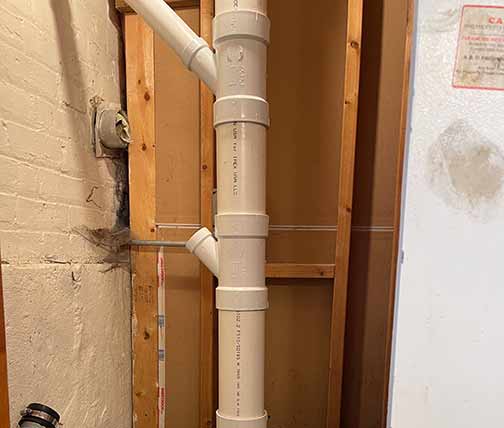
Below we will cover all the essential information you need to know about plumbing stacks. Whether you are a homeowner, a renter, or a plumbing enthusiast, understanding plumbing stacks is crucial for maintaining a healthy and functional plumbing system.
What is a Plumbing Stack?
A plumbing stack, also referred to as a soil stack or a waste stack, is an essential component of a building’s plumbing system. It plays a vital role in transporting wastewater and sewage from different fixtures in a building to the main sewer or septic tank. Essentially, a plumbing stack is the vertical pipe that connects all the drainage pipes in a house or building.
The Function of a Plumbing Stack
The primary function of a plumbing stack is to provide a passage for waste and wastewater to flow out of a building efficiently. It serves as a vent pipe and a drain pipe simultaneously. Here’s how it works:
- Drainage: When water is used in any plumbing fixture, such as a sink, toilet, or shower, it flows through the fixture’s drainpipe and enters the plumbing stack.
- Venting: As wastewater enters the plumbing stack, air is required to prevent the formation of a vacuum. The plumbing stack serves as the vent pipe, allowing air to enter and equalize pressure within the drainage system.
- Transportation: Once the wastewater reaches the plumbing stack, it begins its descent towards the main sewer or septic tank. Gravity aids in the movement of wastewater, guiding it through the vertical plumbing stack and out of the building.
Types of Plumbing Stacks
There are two main types of plumbing stacks commonly found in residential and commercial buildings:
- Soil Stacks: Soil stacks are responsible for transporting solid and liquid waste from toilets. They are designed to handle larger volumes of waste and are usually larger in diameter compared to waste stacks.
- Waste Stacks: Waste stacks are responsible for transporting liquid waste from fixtures such as sinks, bathtubs, and showers. They carry relatively less solid waste compared to soil stacks and are generally smaller in diameter.
Both soil stacks and waste stacks play a crucial role in maintaining a functional plumbing system.

The stack pipe is the main vertical pipe that extends from the basement or ground floor to the roof of the building. It connects all the different fixtures’ drainpipes within the building.
The Components of a Plumbing Stack
A plumbing stack consists of several components that work together to ensure the smooth flow of wastewater and ventilation in a building. Here are the key components:
- Stack Pipe: The stack pipe is the main vertical pipe that extends from the basement or ground floor to the roof of the building. It connects all the different fixtures’ drainpipes within the building.
- Branch Vent: Branch vents are secondary vent pipes connected to individual fixtures. They provide additional ventilation and prevent traps from being siphoned.
- Fixture Drain Pipes: These pipes connect the various plumbing fixtures, such as toilets, sinks, bathtubs, and showers, to the stack pipe.
- Sanitary Tee: A sanitary tee is a specific type of fitting used to connect fixture drain pipes to the stack pipe. It allows wastewater to flow into the stack while also providing a vent connection.
- Vent Flashing: Located on the roof, the vent flashing prevents water from entering the plumbing stack while allowing air to escape.
The Importance of Proper Ventilation
Proper ventilation within a plumbing system is crucial for a few reasons:
- Preventing Trap Siphonage: Ventilation prevents siphoning of water from traps, which could lead to the release of foul odors and the potential for harmful gases, such as sewer gas, to enter the building.
- Preventing Pressure Imbalances: Ventilation equalizes pressure within the plumbing system, preventing slow drainage, gurgling sounds, and the potential for clogs.
- Increasing Plumbing System Efficiency: Adequate ventilation improves the efficiency and effectiveness of the plumbing system, ensuring smooth wastewater flow and minimizing the risk of backups and overflows.
Signs of Plumbing Stack Issues
Identifying potential issues with your plumbing stack is crucial for addressing them before they escalate. Here are some common signs of plumbing stack problems:
- Gurgling Sounds: If you hear gurgling sounds coming from your drains or toilets, it could indicate a problem with your plumbing stack.
- Slow Draining: If water is slow to drain from your sinks, bathtubs, or showers, there may be an obstruction in your plumbing stack.
- Unpleasant Odors: Foul odors emanating from your drains could be a sign of a plumbing stack issue, such as a dried-out trap or a ventilation problem.
- Backups and Overflows: If wastewater starts backing up into your sinks, bathtubs, or toilets, it is essential to address the issue quickly.
- Water Stains on Ceilings or Walls: Water stains on ceilings or walls can indicate a leak or a crack in your plumbing stack.
Maintaining and Fixing Plumbing Stack Issues
To ensure your plumbing stack remains in optimal condition, regular maintenance is vital. Here are some maintenance tips:
- Prevent Clogs: Use drain covers and avoid flushing or draining objects that can cause blockages in your plumbing stack.
- Proper Ventilation: Ensure your plumbing stack is properly vented to prevent pressure imbalances and siphoning.
- Regular Inspections: Schedule periodic inspections by a professional plumber to identify and address any potential plumbing stack issues.
- Prompt Repairs: If you notice any signs of plumbing stack problems, such as slow draining or unusual sounds, contact a professional plumber to address the issue promptly.
In Conclusion
A plumbing stack is a critical component of any building’s plumbing system. Understanding its function, types, and importance of proper ventilation allows you to maintain a healthy and functional plumbing system. By being aware of the signs of plumbing stack issues and following proper maintenance practices, you can ensure the longevity and efficiency of your plumbing stack for years to come.
